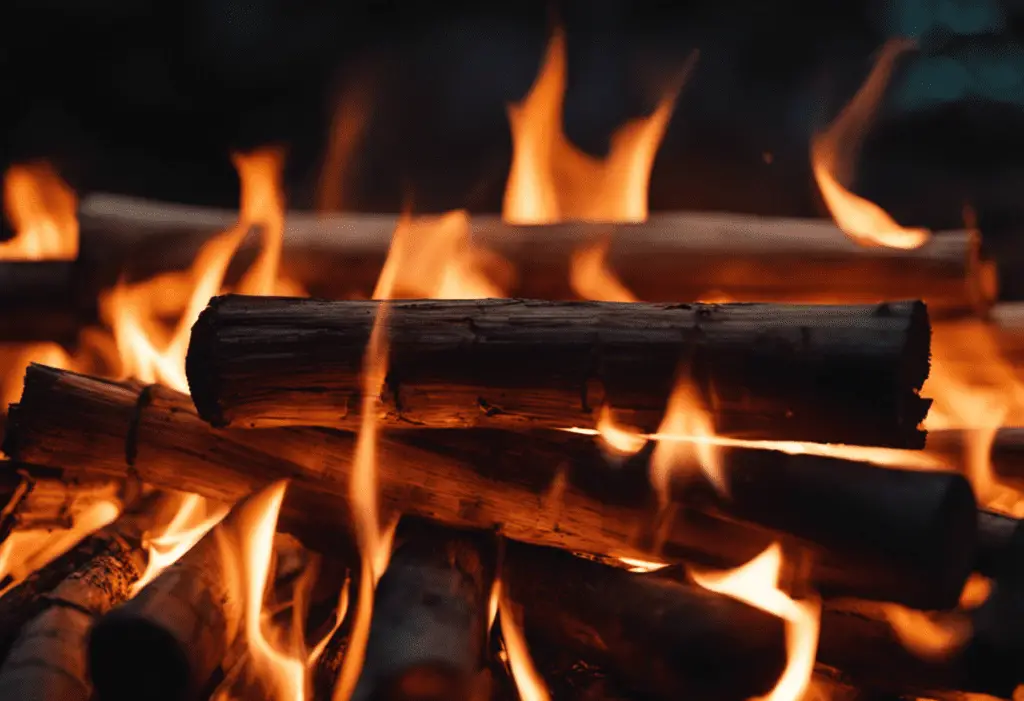Burning bamboo has emerged as a potential alternative to traditional firewood, given its rapid growth, low moisture content, and high calorific value. This article aims to objectively explore the pros and cons of using bamboo as firewood, while also discussing potential safety concerns and alternative uses of bamboo waste.
By providing research-based insights on its accessibility, heat generation, and environmental impact, readers can gain a comprehensive understanding of whether burning bamboo is a viable option for their firewood needs.
Key Takeaways
- Bamboo is easy to cut, split, dry, and use as firewood, making it convenient for those who have it growing on their property.
- Burning bamboo gives off a lot of heat quickly, making it a good option for starting a fire or stove.
- Bamboo can be burned together with other woods and used as kindling for faster fire ignition.
- However, there are some cons to burning bamboo, such as the risk of explosions if not used correctly, the need for frequent feeding of the stove due to its fast burn rate, and the amount of ash it leaves behind.
Pros of Bamboo as Firewood

Bamboo offers several advantages as firewood.
First, it is a fast-growing and renewable resource, making it an environmentally sustainable choice.
Second, bamboo burns hot and fast, making it ideal for use as kindling or for quickly starting a fire.
Additionally, bamboo is easy to cut and split, and it produces less smoke and has a low ash content compared to many other types of firewood.
Fast Growing and Renewable
With its rapid growth rate and ability to regenerate quickly, bamboo offers a sustainable and renewable option for firewood. Bamboo cultivation methods have been developed to ensure its continuous supply for various purposes, including as firewood.
The fast growth of bamboo allows for efficient harvesting, making it an attractive alternative to traditional slow-growing hardwoods. Additionally, bamboo firewood provides an excellent option for cooking, as it burns quickly and gives off a lot of heat.
Its availability and cost-effectiveness make it a popular choice for campers and outdoor enthusiasts. Moreover, bamboo firewood can be used in combination with other woods to produce quick and sustained hot flames.
Burns Hot and Fast (makes great kindling)
Due to its high calorific value and rapid burn rate, bamboo makes an excellent choice for kindling as it burns hot and fast. This characteristic of bamboo makes it ideal for starting a fire quickly and efficiently.
When used as kindling, bamboo can ignite other firewood easily, allowing for a faster and sustained burn. This makes it a convenient option for those who need a quick source of heat, such as campers or individuals using wood stoves.
Additionally, using bamboo as firewood can have sustainability benefits. Bamboo is a fast-growing and renewable resource, which means it can be harvested without depleting the plant population. Furthermore, using bamboo waste as firewood provides an alternative use for this material, reducing waste and promoting resource efficiency.
However, it is important to note that bamboo burns out quickly, so it may not be suitable as the sole burning material for longer-lasting fires.
Easy to Cut and Split
One advantage of using bamboo as firewood is its ease of cutting and splitting. When considering bamboo as a firewood option, its ease of preparation can be a significant factor. Here are some reasons why bamboo is easy to cut and split:
- Lightweight and flexible: Bamboo is lightweight and flexible, making it easier to handle and maneuver during the cutting and splitting process.
- Straight and uniform shape: Bamboo culms grow straight and have a relatively uniform shape, which makes them easier to cut into manageable pieces and split into firewood.
- Soft and easy to work with: Bamboo has a softer texture compared to hardwoods, making it easier to cut and split using basic hand tools.
- Less resistance: Due to its structure and composition, bamboo offers less resistance when cutting and splitting, making the process quicker and less strenuous.
Considering its ease of cutting and splitting, bamboo can be a viable option for those seeking sustainable heating options or looking for bamboo firewood alternatives. Additionally, its easy ignition properties make it suitable as kindling for starting fires.
Produces Less Smoke
Bamboo produces less smoke when burned, making it a favorable choice as firewood. This reduced smoke production has several benefits, particularly in terms of its environmental impact.
Smoke from burning wood is a significant contributor to carbon emissions and climate change. By choosing bamboo as firewood, the amount of smoke released into the atmosphere is reduced, thereby minimizing its impact on carbon emissions. This is especially important considering that burning wood is responsible for an estimated two million deaths annually.
Furthermore, bamboo’s fast growth rate and sustainability make it an environmentally-friendly option for fuel consumption.
Low Ash Content
Generally, bamboo has a relatively low ash content when burned, making it a preferred choice as firewood. Here are some reasons why bamboo’s low ash content is beneficial:
- Environmental sustainability: Bamboo is a fast-growing and renewable resource, making it an environmentally friendly option for fuel consumption. It helps reduce reliance on traditional hardwoods, which often come from slow-growing trees.
- Efficient fuel source: Due to its low ash content, bamboo burns efficiently and provides a steady and sustained heat output. This makes it an ideal choice for heating purposes, such as in stoves or fireplaces.
- Proper bamboo preparation: To ensure optimal burning and minimize ash production, it is important to properly prepare bamboo. This involves harvesting mature and dead bamboo culms, allowing them to dry for a few months, and cutting them into smaller pieces suitable for burning.
- Overall, the low ash content of bamboo contributes to its practicality as a firewood option, offering both environmental sustainability and efficient fuel properties.
Cons of Bamboo as Firewood
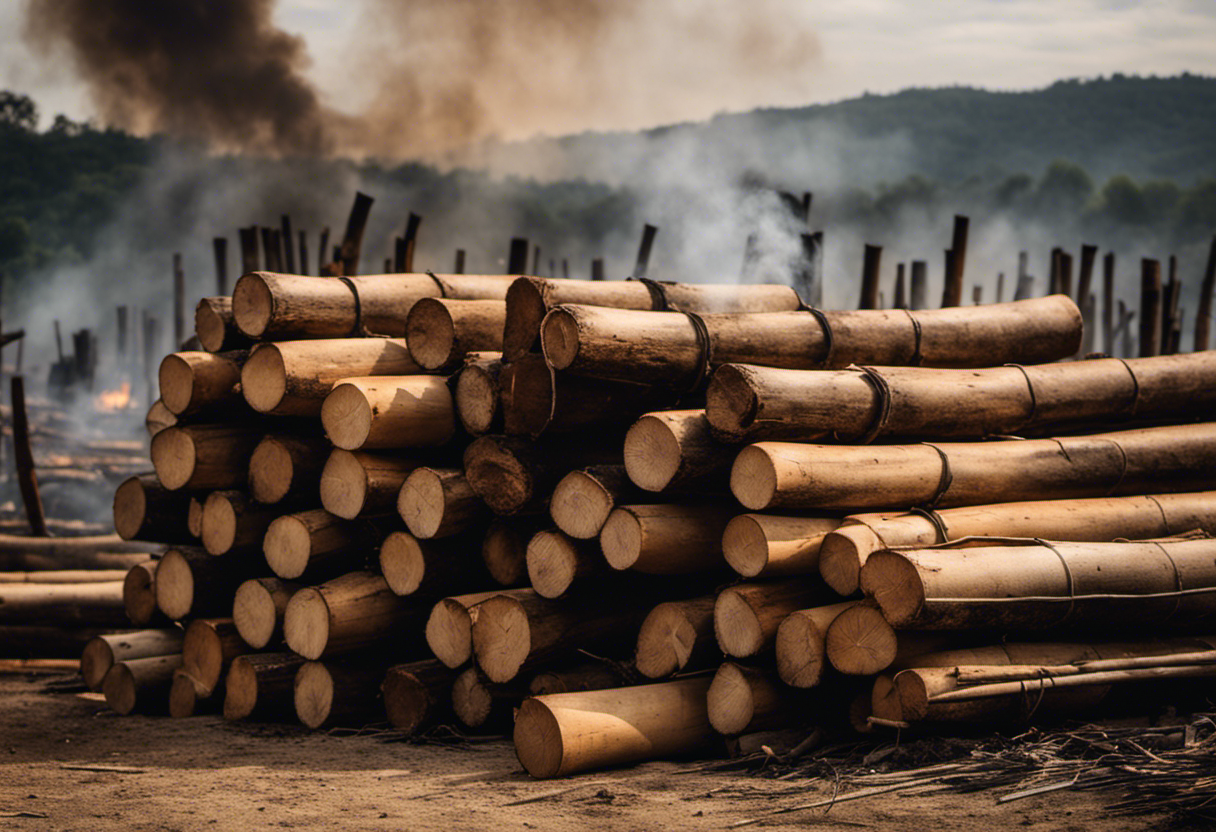


There are several drawbacks to using bamboo as firewood.
First, bamboo burns out quickly, requiring frequent feeding of the stove.
Second, there is a risk of explosion if the bamboo is not used correctly, as air trapped inside the bamboo can cause explosions.
Burns Out Quickly
One major drawback of using bamboo as firewood is that it burns out relatively quickly, requiring frequent feeding of the stove. This can be inconvenient, especially if you are using bamboo for cooking or heating purposes.
Here are some reasons why bamboo burns out quickly:
- Low density: Bamboo has a lower density compared to traditional hardwoods, which means it contains less energy per unit volume. As a result, it burns faster and does not provide sustained heat over a long period of time.
- High moisture content: Bamboo has a relatively high moisture content, which contributes to its quick burn rate. This moisture needs to be dried out before using bamboo as firewood, but even then, it will still burn out faster compared to other types of wood.
- Lack of density: Bamboo is not as dense as hardwoods, which affects its burn time. The lack of density means that it burns more quickly and requires more frequent feeding of the stove to maintain a consistent fire.
- Size and shape: The size and shape of bamboo culms can also contribute to its quick burn rate. The hollow nature of bamboo allows air to circulate inside, promoting faster combustion and faster burnout.
While bamboo can be used as a sustainable firewood option, it is important to consider its burn characteristics and be prepared for the need to frequently feed the stove to maintain a steady fire.
Risk of Explosion
Occasionally, bamboo used as firewood can pose a risk of explosion if not used correctly. The risk of explosion arises from the air trapped inside the bamboo culms. When bamboo is burned, the moisture inside heats up and turns into steam, causing a build-up of pressure. If this pressure is not released properly, it can lead to an explosion.
To prevent explosions, it is important to properly split the bamboo into smaller pieces, allowing the trapped air to escape. Additionally, it is crucial to ensure proper ventilation when burning bamboo to avoid the accumulation of steam and pressure.
It is also important to note that burning bamboo can produce harmful fumes when inhaled directly or in high volumes, which can pose health risks. Therefore, it is essential to take precautionary measures while using bamboo as firewood.
Despite these risks, bamboo charcoal briquettes can be a sustainable alternative to traditional firewood, as they are made from bamboo plants harvested after at least five years of growth and help reduce deforestation caused by wood charcoal consumption.
Wet Bamboo Burns Poorly
Despite its many advantages, wet bamboo burns poorly as firewood due to its high moisture content, making it less efficient and less effective in producing heat. When bamboo is wet, it can be challenging to ignite and maintain a steady fire. Here are some reasons why wet bamboo is not an ideal firewood option:
- High moisture content: Wet bamboo contains a significant amount of water, which hinders combustion and slows down the burning process.
- Inefficient heat production: Due to its moisture content, wet bamboo produces less heat compared to dry firewood, resulting in a less effective heating source.
- Increased smoke and emissions: Wet bamboo tends to produce more smoke and emissions when burned, leading to a less environmentally friendly option.
- Difficulty in storage and drying: Wet bamboo requires proper storage and drying methods to reduce its moisture content and make it suitable for burning. This process can be time-consuming and may require additional resources.
To overcome the challenges of wet bamboo, consider using slow-burning alternatives or implementing firewood drying methods to ensure optimal burning efficiency and heat production.
Is Burning Bamboo Harmful
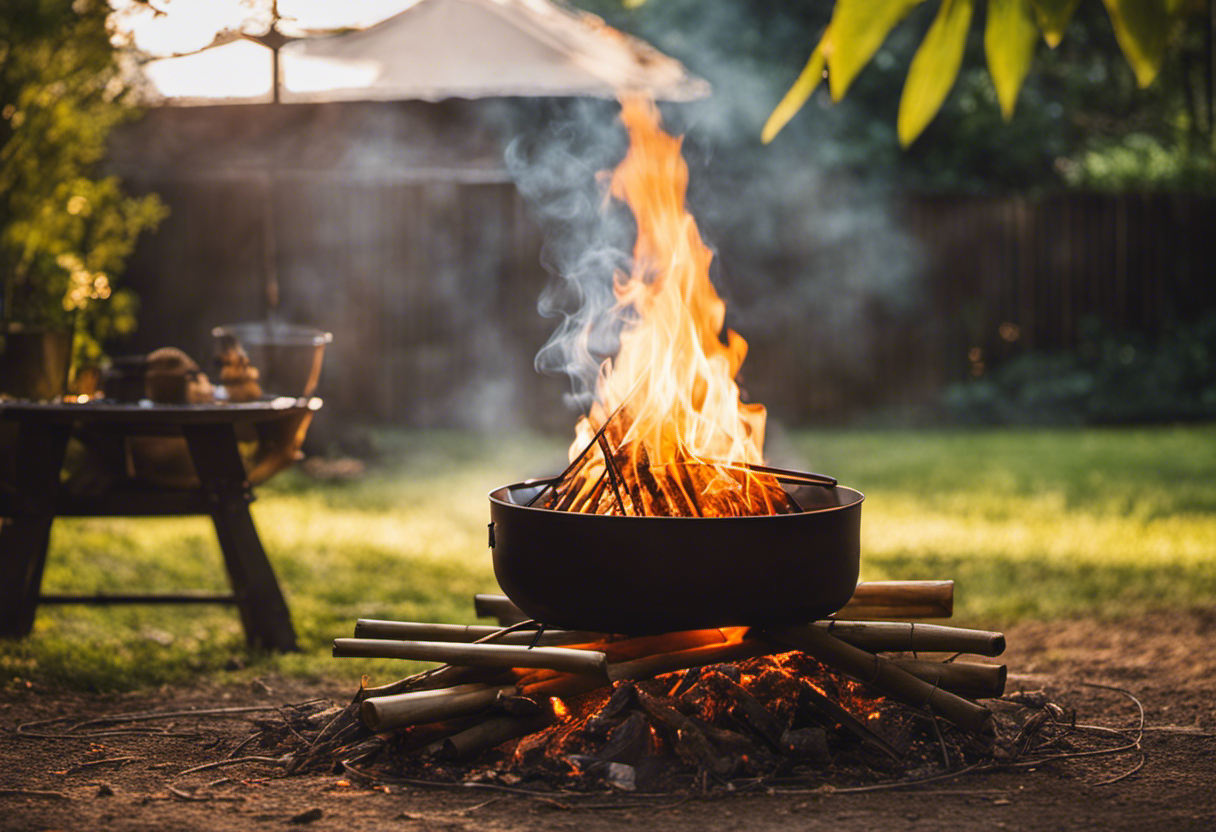


Burning bamboo can potentially release harmful fumes that pose health risks when inhaled directly or in high volumes. While bamboo is often touted as a sustainable and renewable source of firewood, it is important to consider the potential harmful effects and take necessary safety precautions.
When bamboo is burned, it can produce fumes that may contain pollutants such as carbon monoxide and volatile organic compounds (VOCs). Inhaling these fumes can lead to respiratory issues, irritation of the eyes and throat, and even carbon monoxide poisoning in severe cases.
To minimize the harmful effects of burning bamboo, it is important to ensure proper ventilation when using it as firewood. This can be achieved by opening windows or using a well-ventilated fireplace or stove. Additionally, it is advisable to avoid burning bamboo indoors without proper ventilation, especially for individuals with asthma or lung diseases.
In terms of environmental impact, burning bamboo can be a sustainable choice as it is a fast-growing and easily cultivated plant. However, it is crucial to consider the source of the bamboo and ensure that it is harvested responsibly to prevent deforestation and habitat destruction.
Environmental Impact
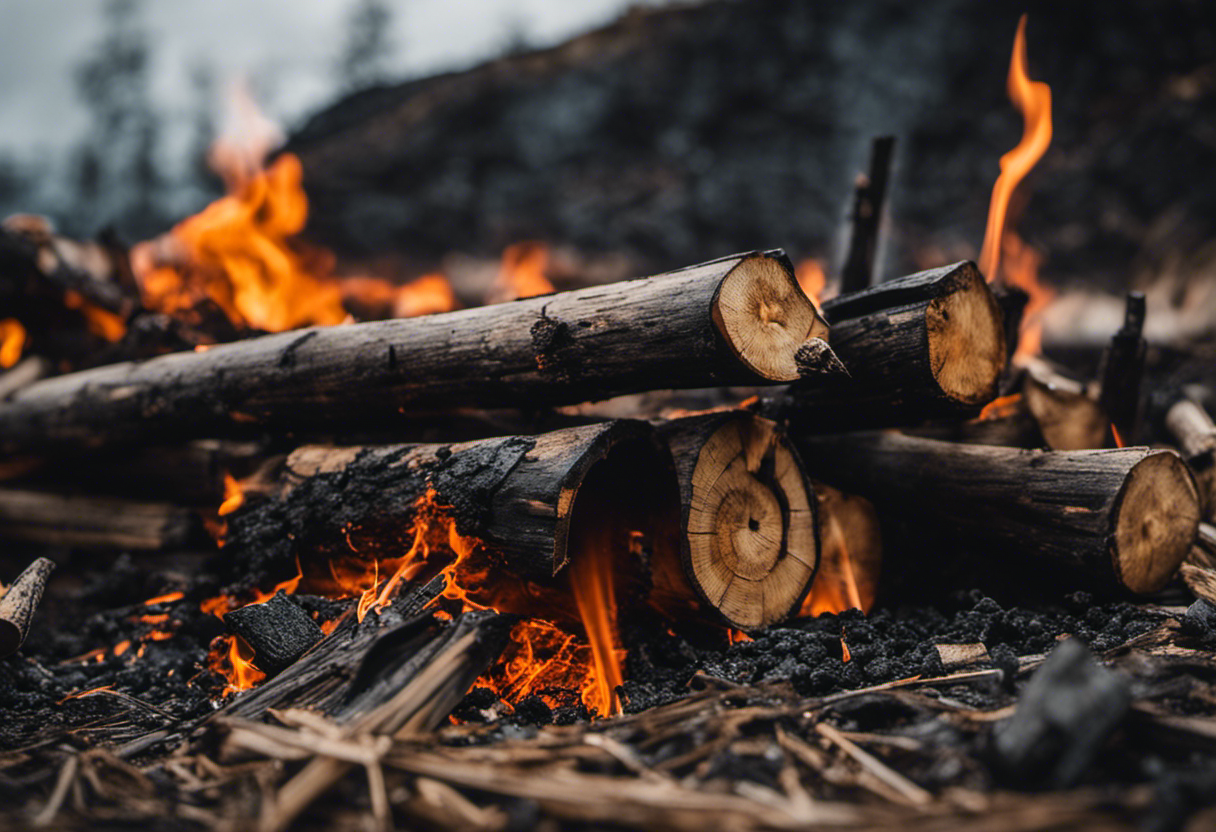


When considering the environmental impact of burning bamboo as firewood, several points should be addressed.
Firstly, the impact on carbon emissions and climate should be examined, as bamboo has the potential to be a more sustainable alternative to traditional firewood.
Secondly, the pollutants released from burning bamboo should be analyzed to determine any potential negative effects on air quality.
Lastly, the toxicity and safety aspects of burning bamboo should be considered to ensure that it does not pose any health risks to individuals.
Impact on carbon emissions and climate
Bamboo as firewood has the potential to reduce carbon emissions and mitigate the impact on climate due to its fast growth and sustainable characteristics. Here are four reasons why bamboo can have a positive impact on carbon emissions and climate:
- Rapid growth rate: Bamboo can grow up to 3 feet per day and reach maturity in just 3 to 5 years. This fast growth means that bamboo can be harvested more frequently, providing a continuous and sustainable fuel source.
- Carbon sequestration: Bamboo is known for its ability to absorb carbon dioxide from the atmosphere. As it grows, bamboo sequesters carbon, helping to reduce greenhouse gas emissions and mitigate climate change.
- Renewable resource: Bamboo is a fast-growing and easily cultivated plant, making it a renewable resource for firewood. Unlike traditional hardwoods, which can take decades to grow, bamboo can be harvested more frequently without depleting the resource.
- Low transportation emissions: Bamboo is often grown locally, reducing the need for long-distance transportation. This helps to minimize carbon emissions associated with the transportation of firewood.
Pollutants released from burning
The release of pollutants from the burning of bamboo can have significant environmental impacts. When bamboo is burned, it releases various pollutants into the air, including carbon dioxide (CO2), carbon monoxide (CO), volatile organic compounds (VOCs), and particulate matter (PM).
These pollutants contribute to air pollution and can have detrimental effects on human health and the environment. CO2 is a major greenhouse gas that contributes to climate change. CO is a toxic gas that can be harmful when inhaled in high concentrations. VOCs can react with sunlight to form ground-level ozone, which is a harmful air pollutant. PM consists of tiny particles that can be inhaled and cause respiratory issues.
To mitigate the environmental impact of burning bamboo, proper safety precautions such as ensuring proper ventilation and following local fire safety regulations should be taken.
Toxicity and Safety
Burning bamboo poses potential risks to human health and the environment due to the release of harmful pollutants and toxins. It is important to consider the toxicity concerns, proper ventilation, and health risks associated with burning bamboo as firewood.
Toxicity concerns:
- Burning bamboo produces fumes that can be harmful when inhaled directly or in high volumes.
- Bamboo may contain lead and other heavy metals, although this has not been proven by studies.
- Burning wood poses even more health risks and causes an estimated two million deaths annually.
Proper ventilation:
- Burning bamboo indoors without proper ventilation increases the risk of lung cancer.
- It is not advisable to burn bamboo if you have asthma or a lung disease.
Health risks:
- Bamboo may be less toxic than burning wood, but precautions should still be taken.
- It is important to ensure proper ventilation and avoid prolonged exposure to the smoke.
Environmental impact:
- Bamboo is a fast-growing, renewable resource, but it is important to consider its sustainability as firewood.
- Properly preparing and burning bamboo can help reduce the release of harmful pollutants and minimize the environmental impact.
Precautions for safe burning



When considering the safe burning of bamboo, it is important to take certain precautions to prevent accidents and ensure a controlled and efficient fire. Bamboo, like any other firewood, should be handled with care to minimize the risk of injury or property damage.
Firstly, it is essential to properly prepare the bamboo before burning. Harvest mature and dead bamboo culms that are at least 3-4 years old. Cut the stalks as close to the ground as possible and remove any branches and leaves. Allow the bamboo to dry for at least 2-3 months to achieve a low moisture content. This will help prevent rapid burning and reduce the risk of chimney fires.
When burning bamboo, it is crucial to ensure proper ventilation. Open windows or doors to allow fresh air to circulate and avoid the buildup of smoke and harmful fumes. Additionally, following local fire safety regulations and guidelines is essential to prevent accidents and ensure the safety of both individuals and property.
Furthermore, regularly cleaning and maintaining chimneys is necessary to prevent creosote buildup, which can lead to chimney fires. Creosote is a byproduct of burning bamboo and can accumulate on the chimney walls, increasing the risk of a dangerous fire.
In terms of the impact on air quality, burning bamboo produces less smoke than many other types of firewood. However, it is still important to be mindful of the potential health risks associated with inhaling smoke and fumes from any burning material. Individuals with asthma or lung diseases should avoid burning bamboo indoors without proper ventilation.
Other Uses for Bamboo Waste – Mulch, Animal Bedding, Compost
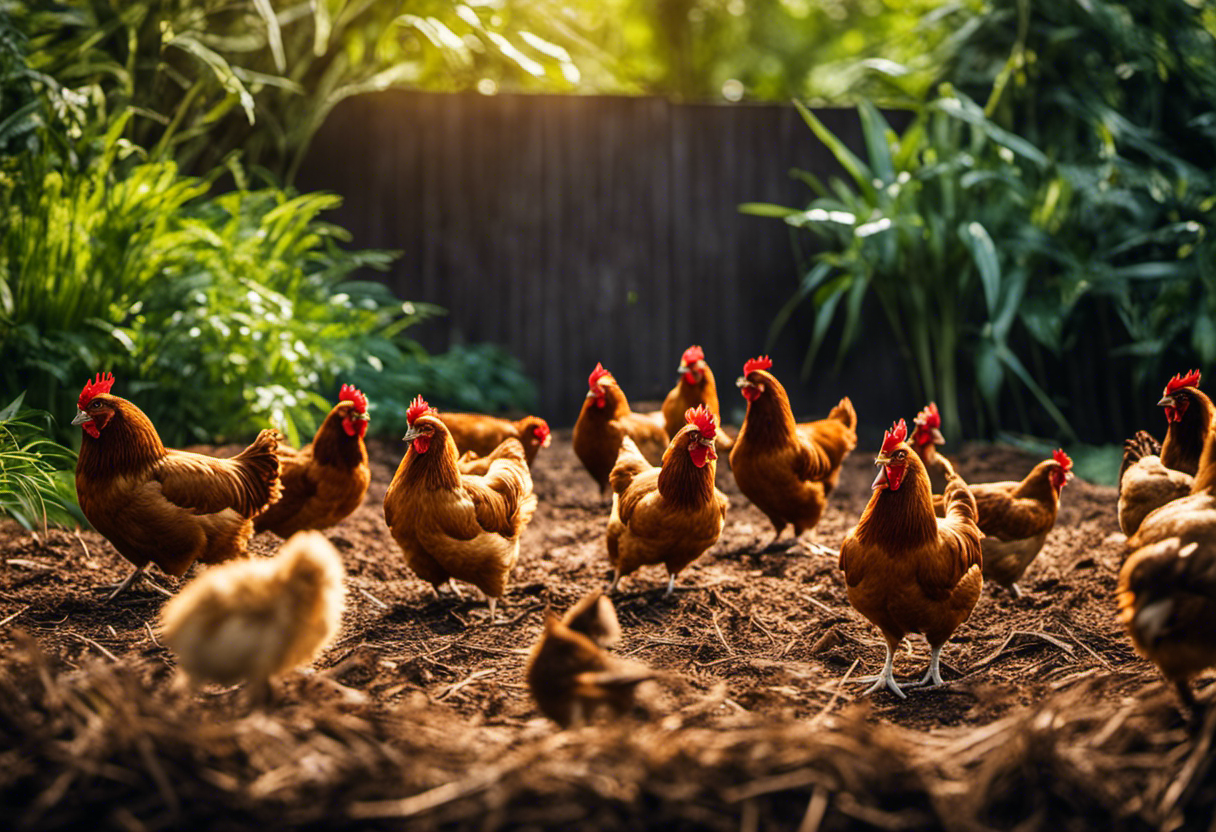


Bamboo waste can be repurposed for various uses, including mulch, animal bedding, and compost. Here are some benefits and options for utilizing bamboo waste:
- Mulch Benefits:
- Bamboo mulch helps suppress weed growth by blocking sunlight and preventing weed germination.
- It retains moisture in the soil, reducing the need for frequent watering.
- Bamboo mulch decomposes slowly, providing a long-lasting source of nutrients for plants.
- It can help regulate soil temperature, keeping it cooler in hot weather and warmer in cold weather.
- Composting Techniques:
- Bamboo waste can be composted to create nutrient-rich soil amendments.
- Chop bamboo into smaller pieces to speed up the decomposition process.
- Mix bamboo waste with other organic materials, such as kitchen scraps and yard trimmings, to balance the carbon-to-nitrogen ratio.
- Turn the compost pile regularly to promote aeration and decomposition.
- Animal Bedding Options:
- Bamboo waste can be used as bedding for animals, such as chickens, rabbits, and small livestock.
- It provides a comfortable and absorbent bedding material that helps control odors.
- Bamboo bedding is biodegradable and can be composted after use.
- It is a sustainable alternative to traditional bedding materials like straw or wood shavings.
Conclusion
In conclusion, burning bamboo can be a viable firewood option due to its rapid growth, low moisture content, and high calorific value. It offers easy accessibility and quick heat generation while contributing to reduced deforestation.
However, there are considerations such as the potential for explosions, frequent stove feeding, and significant ash production. Safety precautions should be taken, and alternative uses for bamboo waste, such as mulch, animal bedding, and compost, should also be explored.
Overall, bamboo can be a sustainable and efficient choice for firewood.

